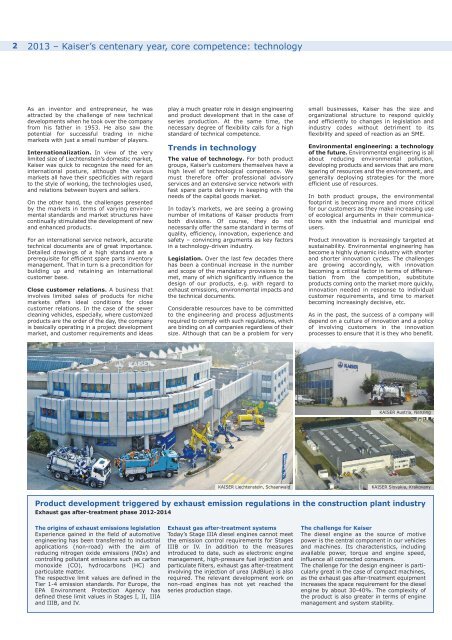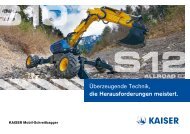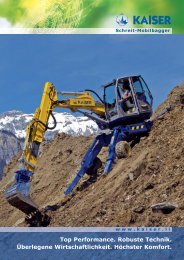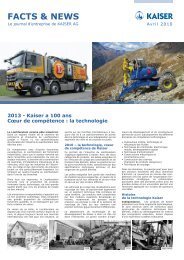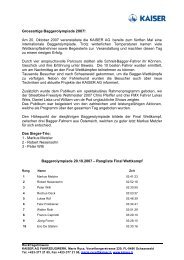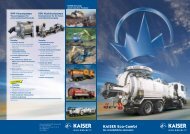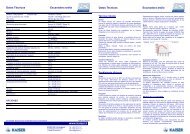Kaiser's - Kaiser AG
Kaiser's - Kaiser AG
Kaiser's - Kaiser AG
Create successful ePaper yourself
Turn your PDF publications into a flip-book with our unique Google optimized e-Paper software.
2<br />
2013 – <strong>Kaiser</strong>’s centenary year, core competence: technology<br />
As an inventor and entrepreneur, he was<br />
attracted by the challenge of new technical<br />
developments when he took over the company<br />
from his father in 1953. He also saw the<br />
potential for successful trading in niche<br />
markets with just a small number of players.<br />
Internationalization. In view of the very<br />
limited size of Liechtenstein’s domestic market,<br />
<strong>Kaiser</strong> was quick to recognize the need for an<br />
international posture, although the various<br />
markets all have their specificities with regard<br />
to the style of working, the technologies used,<br />
and relations between buyers and sellers.<br />
On the other hand, the challenges presented<br />
by the markets in terms of varying environmental<br />
standards and market structures have<br />
continually stimulated the development of new<br />
and enhanced products.<br />
For an international service network, accurate<br />
technical documents are of great importance.<br />
Detailed drawings of a high standard are a<br />
prerequisite for efficient spare parts inventory<br />
management. That in turn is a precondition for<br />
building up and retaining an international<br />
customer base.<br />
Close customer relations. A business that<br />
involves limited sales of products for niche<br />
markets offers ideal conditions for close<br />
customer relations. In the case of the sewer<br />
cleaning vehicles, especially, where customized<br />
products are the order of the day, the company<br />
is basically operating in a project development<br />
market, and customer requirements and ideas<br />
Product development triggered by exhaust emission regulations in the construction plant industry<br />
Exhaust gas after-treatment phase 2012-2014<br />
The origins of exhaust emissions legislation<br />
Experience gained in the field of automotive<br />
engineering has been transferred to industrial<br />
applications (non-road) with the aim of<br />
reducing nitrogen oxide emissions (NOx) and<br />
controlling pollutant emissions such as carbon<br />
monoxide (CO), hydrocarbons (HC) and<br />
particulate matter.<br />
The respective limit values are defined in the<br />
Tier 1-4 emission standards. For Europe, the<br />
EPA Environment Protection Agency has<br />
defined these limit values in Stages I, II, IIIA<br />
and IIIB, and IV.<br />
play a much greater role in design engineering<br />
and product development that in the case of<br />
series production. At the same time, the<br />
necessary degree of flexibility calls for a high<br />
standard of technical competence.<br />
Trends in technology<br />
The value of technology. For both product<br />
groups, <strong>Kaiser</strong>’s customers themselves have a<br />
high level of technological competence. We<br />
must therefore offer professional advisory<br />
services and an extensive service network with<br />
fast spare parts delivery in keeping with the<br />
needs of the capital goods market.<br />
In today’s markets, we are seeing a growing<br />
number of imitations of <strong>Kaiser</strong> products from<br />
both divisions. Of course, they do not<br />
necessarily offer the same standard in terms of<br />
quality, efficiency, innovation, experience and<br />
safety – convincing arguments as key factors<br />
in a technology-driven industry.<br />
Legislation. Over the last few decades there<br />
has been a continual increase in the number<br />
and scope of the mandatory provisions to be<br />
met, many of which significantly influence the<br />
design of our products, e.g. with regard to<br />
exhaust emissions, environmental impacts and<br />
the technical documents.<br />
Considerable resources have to be committed<br />
to the engineering and process adjustments<br />
required to comply with such regulations, which<br />
are binding on all companies regardless of their<br />
size. Although that can be a problem for very<br />
Exhaust gas after-treatment systems<br />
Today’s Stage IIIA diesel engines cannot meet<br />
the emission control requirements for Stages<br />
IIIB or IV. In addition to the measures<br />
introduced to date, such as electronic engine<br />
management, high-pressure fuel injection and<br />
particulate filters, exhaust gas after-treatment<br />
involving the injection of urea (AdBlue) is also<br />
required. The relevant development work on<br />
non-road engines has not yet reached the<br />
series production stage.<br />
small businesses, <strong>Kaiser</strong> has the size and<br />
organizational structure to respond quickly<br />
and efficiently to changes in legislation and<br />
industry codes without detriment to its<br />
flexibility and speed of reaction as an SME.<br />
Environmental engineering: a technology<br />
of the future. Environmental engineering is all<br />
about reducing environmental pollution,<br />
developing products and services that are more<br />
sparing of resources and the environment, and<br />
generally deploying strategies for the more<br />
efficient use of resources.<br />
In both product groups, the environmental<br />
footprint is becoming more and more critical<br />
for our customers as they make increasing use<br />
of ecological arguments in their communications<br />
with the industrial and municipal end<br />
users.<br />
Product innovation is increasingly targeted at<br />
sustainability. Environmental engineering has<br />
become a highly dynamic industry with shorter<br />
and shorter innovation cycles. The challenges<br />
are growing accordingly, with innovation<br />
becoming a critical factor in terms of differentiation<br />
from the competition, substitute<br />
products coming onto the market more quickly,<br />
innovation needed in response to individual<br />
customer requirements, and time to market<br />
becoming increasingly decisive, etc.<br />
As in the past, the success of a company will<br />
depend on a culture of innovation and a policy<br />
of involving customers in the innovation<br />
processes to ensure that it is they who benefit.<br />
KAISEr Austria, Nenzing<br />
KAISEr Liechtenstein, Schaanwald KAISEr Slovakia, Krakovany<br />
The challenge for <strong>Kaiser</strong><br />
The diesel engine as the source of motive<br />
power is the central component in our vehicles<br />
and machines. Its characteristics, including<br />
available power, torque and engine speed,<br />
influence all connected consumers.<br />
The challenge for the design engineer is particularly<br />
great in the case of compact machines,<br />
as the exhaust gas after-treatment equipment<br />
increases the space requirement for the diesel<br />
engine by about 30-40%. The complexity of<br />
the product is also greater in terms of engine<br />
management and system stability.


